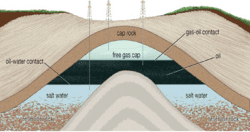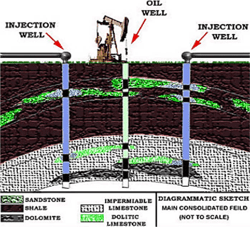Oil and gas are formed from the remains of organisms that are decayed in the sedimentary rock alongside with the minerals of the rock. When these rocks are buried by overlying sediment, the organic matter decomposes and converts to oil and natural gas through bacterial processes coupled with high temperature and pressure. Furthermore, the oil and gas along with water migrate from the rock into adjacent porous reservoir rock (which is usually sandstones, limestone’s, or dolomites). The movement continues until they meet an impermeable rock. Due to the difference in density, gas is found at the top followed by oil and water; an oil reservoir is presented in Figure 1-2 showing the different layers formed by gas, oil and water.
After the oil exploration and drilling process has been achieved, during the production stage of oil and gas, there are three different recovery techniques used; primary, secondary and tertiary recovery techniques. In the primary recovery technique oil is forced to the surface by the reservoir pressure, and pumps could be used when the pressure reduces. The primary recovery techniques account for 10% of oil production [8]. When the reservoir matures and if there is no aquifer water to replace the producing oil, water or gas is been injected into the reservoir to increase the pressure, this technique 2 is known as secondary recovery; it results in the recovery of 20-40 % of the reservoir’s original oil in place. Figure 1-3 gives a vivid explanation of secondary recovery techniques.


Lastly, tertiary recovery techniques (otherwise known as enhanced oil recovery) involve the injection of steam, solvent or bacterial and detergent to improve the oil recovery; these techniques account for 30-70 % of reservoir original oil in place. One of the drawbacks for the use of the last two techniques is that it could lead to the precipitating of solid (scale). The types of scales formed in the oil and gas industry will be discussed in the next section.
Post time: Apr-27-2022
